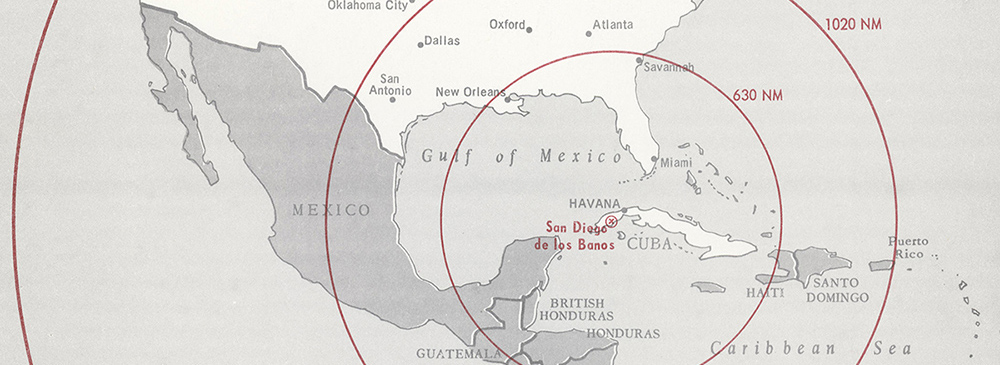
Cuban Missile Crisis
At the height of the Cold War, for two weeks in October 1962, the world teetered on the edge of thermonuclear war. Earlier that fall, the Soviet Union, under orders from Premier Nikita Khrushchev, began to secretly deploy a nuclear strike force in Cuba, just 90 miles from the United States. President John F. Kennedy said the missiles would not be tolerated and insisted on their removal. Khrushchev refused. The standoff nearly caused a nuclear exchange and is remembered in this country as the Cuban Missile Crisis. For 13 agonizing days—from October 16 through October 28—the United States and the Soviet Union stood on the brink of nuclear war. The peaceful resolution of the crisis with the Soviets is considered to be one of Kennedy’s greatest achievements.
Research Resources
- Military Resources: Bay of Pigs Invasion & Cuban Missile Crisis
- John F. Kennedy Library Research Subject Guide: Cuban Missile Crisis
- Cuban Missile Crisis Chronology
- Department of Defense Cuban Missile Crisis Briefing Materials
- CIA-prepared personality studies of Nikita Khrushchev and Fidel Castro
- Satellite images of missile sites under construction
- Secret correspondence between Kennedy and Khrushchev
- National Archives Catalog Subject Finding Aid for Cuban Missile Crisis (Still Picture Branch)
- JFK’s doodles from October 1962
- Aerial Photograph of Missiles in Cuba (1962), Milestone Documents
Audio and Video
- President Kennedy’s radio and television address to the American people on the Soviet arms build-up in Cuba, October 22, 1962
- President Kennedy’s radio and television remarks on the dismantling of Soviet missile bases in Cuba, November 2, 1962
- Telephone conversation between President Kennedy and former President Truman, October 28, 1962
- Telephone conversation between President Kennedy and former President Eisenhower, October 28, 1962
- Telephone recordings, Cuban Missile Crisis Update, October 22, 1962
- Atomic Gambit: JFK Library podcast for 60th anniversary
- Poise, Professionalism and a Little Luck, the Cuban Missile Crisis 1962 (panel discussion)
- Nuclear Folly: A History of the Cuban Missile Crisis (author lecture)
Kennedy Library Forums
- Cuban Missile Crisis: An Historical Perspective (October 6, 2002)
- On the Brink: The Cuban Missile Crisis (October 20, 2002)
- The Cuban Missile Crisis: An Eyewitness Perspective (October 17, 2007)
- Presidency in the Nuclear Age: Cuban Missile Crisis and the First Nuclear Test Ban Treaty (October 12, 2009)
- 50th Anniversary of the Cuban Missile Crisis (October 14, 2012)
-
The Cuban Missile Crisis: Lessons for Today (October 22, 2022)
Articles and Blog Posts
- One Step from Nuclear War—The Cuban Missile Crisis at 50 (Prologue)
- Forty Years Ago: The Cuban Missile Crisis (Prologue)
- Cuban Missile Crisis, Revisited (Text Message blog)
-
60th Anniversary: The Cuban Missile Crisis (Unwritten Record)
Education Resources
- The Cuban Missile Crisis: How to Respond? (high school curriculum resource)
- World on the Brink: JFK and the Cuban Missile Crisis (online exhibit)


